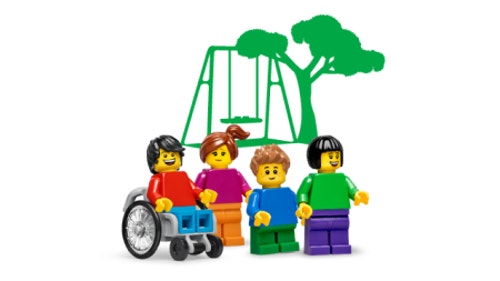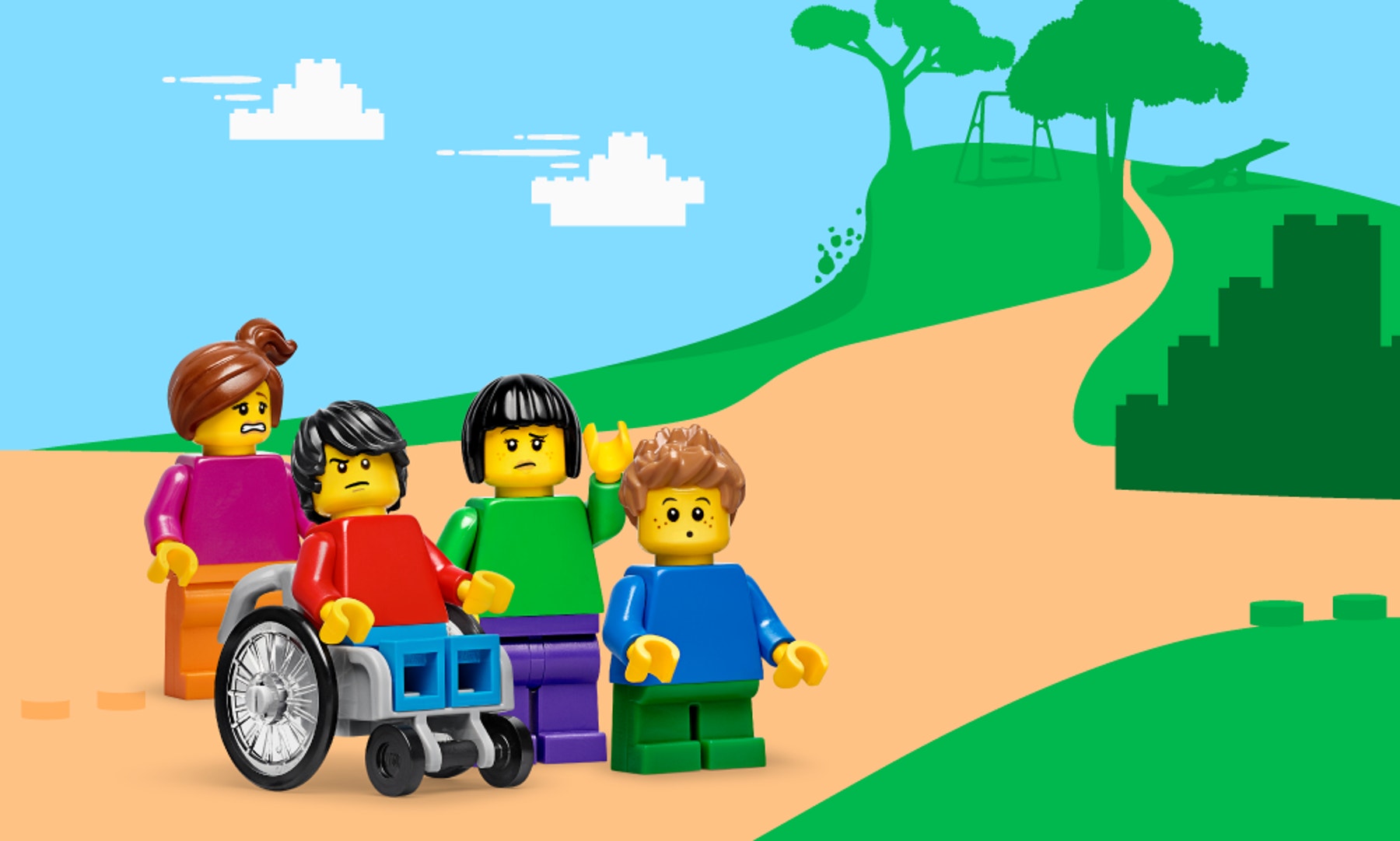Protection from Wind
Daniel, Sofie, Leo and Maria felt a strong wind at the park. It blew a lot of the soil away. What could happen to the animals in the park? Can you help the team protect the soil?

Prepare
(NOTE: This lesson contains a Part A and a Part B. Both are important to access the full learning of the curriculum. If time is limited, review both parts to choose elements that meet your students’ needs.)
In this lesson, the key learning is about comparing multiple solutions to a problem. Each student group will create and build a design solution to slow or prevent wind from changing the shape of land (at the park) and then the groups will compare the class solutions.
The lesson provides some suggestions for inspiration. Encourage students to build their own ideas for a windbreak or other wind protection method. Reinforce that there is no single correct model.
- Science Background - Protection from Wind: In this lesson, the windbreak model can include different design solutions, including lines of trees or bushes, walls, etc. Models should work as a windbreak for a fan-strength wind.
- Build Prior Knowledge - Protection from Wind: Using your core science materials, share information, images and definitions.
- The wind causes the surface of the land to weather by blowing particles against landforms such as rocks and cliffs. This slowly wears away their surface and breaks them into smaller pieces.
- The wind erodes the surface by carrying away the lighter particles of soil, such as silt and sand. This leaves the heavier particles behind and makes the land surface lower and rockier over time.
- People use different ways to slow or prevent the changes in the shape of the land caused by wind or water, including windbreaks made of walls, trees or bushes. Sometimes farmers in windy areas grow plants like grasses because they help hold the soil so it can’t blow away.
- Key vocabulary: erosion, erode, weathering (optional – particles, landforms)
- Building and Programming Experience: Consider the suggestions in the Unit Plan. For this lesson, you may also want to
- Try one or more of the lessons in this Amazing Amusement Park unit to support students’ building and programming skills and prepare them for the challenges in this lesson.
- Materials
- Locate age-appropriate resources about weathering and wind erosion for the Extension, as well as craft materials students may use in their lesson models. Decide how you will share them for student access.
PART A (45 Minutes)
Engage
(Whole Class, 10 minutes)

Introduce the story’s main character(s) and the first challenge: Daniel, Sofie, Leo and Maria felt a strong wind at the park. It blew a lot of soil away. What could happen to the animals in the park? Can you help the team protect the soil?
THINK – Facilitate a brief discussion about the lesson topic(s), using the story picture if you wish.
- What could happen to the soil in the park if the wind blows a lot over time? How would this change the shape of the land? (It could blow away. Over time, the wind would wear away the soil, making the park rockier or changing its shape.)
- What is weathering? What is erosion? What causes them? How could they cause a problem for the animals in the park? (Possible answers: Weathering happens when water or wind breaks down large landforms or rocks into smaller and smaller particles over time. Erosion happens when wind or water carry away the lightest particles from the lands surface. Both can be caused by wind, waves, rain and ice. Both change the shape of the land. Erosion that blows the soil at the park away could cause a problem for the animals by affecting their home or food supply.)
- What are some ways to protect the soil at the park from wind erosion? (Possible answers: Build a windbreak, such as with a line of trees or bushes and/or walls.)
Distribute a SPIKE Essential Set and a device to each group.
Explore
(Small Groups, 25 minutes)
As students work, clarify that they may design and build any model they wish in this open-project lesson. The windbreak is one idea. Another possible inspiration is the model from the Preparing for the Weather lesson. Students can also fan the set lid back and forth to create some wind. Reinforce that there is no single correct model.
Have students:
- Design a solution to prevent wind from changing the park. Sketch their ideas.
- Exchange ideas using a familiar classroom routine, sharing features and then use inspiration from sharing to choose the best design to iterate and build.
- Begin to BUILD and PROGRAM a model to help Daniel, Sofie, Leo and Maria protect the soil at the park from the wind.
Facilitate brainstorming about ways to use LEGO® elements to build a windbreak; for example, green plant bricks to represent trees; a motor to control windbreaks, etc.
Explain
(Whole Class, 10 minutes)
Gather students for sharing.
Have each group use their progress model to demonstrate and explain;
- Which of their design ideas did they choose to build? Why?
- How does their design to protect the park from wind erosion work? (It should block the wind.)
- How does the model or programming work or fail?
- What changes did they make so it works better?
Have observing students make notes about which designs they think will work best and why. They will compare designs later in the lesson.
Have students keep their partially completed models intact for use in Part B or allow time for rebuilding.
PART B (45 minutes)
Elaborate
(Whole Class, 35 minutes)
Organise a familiar sharing method, such as a Gallery Walk (one partner in each pair presents the design as the other circulates to view classmates’ designs. After half the time, partners switch roles).
- Students should evaluate each design according to whether they think it will slow or prevent soil from being blown away. (To deliver these results, the design should block the wind.)
Have students:
- (10 min) Continue to BUILD and PROGRAM their model of a solution to protect land from wind.
- (10 min) Use their completed models to share their learning about ways to prevent wind from blowing away soil in the park.
- (10 min) Use their Explain notes and observations to evaluate all the models and vote yes or no on whether each will block the wind to protect the soil from being blown away. Add the votes and identify the best solutions.
(5 min) Invite students to share knowledge, ideas or skills that:
- Helped them complete the challenge.
- They learned while building.
Have students clean up the sets and work areas.
Evaluate
(Whole Class, 10 minutes)
- Ask guiding questions to elicit students’ thinking and their decisions while ideating, building and programming.
Observation Checklist
Review the key objectives (Teacher Support box).
Use the checklist to observe students’ progress:
- Their design ideas and sketches show different solutions to slow or prevent wind from changing the land.
- Their model and program reflect one design solution (e.g., a tree windbreak) to protect the soil in the park from wind erosion.
- Their observation notes and final votes on the class multiple design solutions show understanding that the windbreak must block the wind to be effective in preventing wind erosion.
Self-Assessment
Have each student choose the brick that they feel best represents their performance。
- Blue brick: I think I can follow instructions to create a program.
- Yellow brick: I can follow instructions to create a program.
- Green brick: I can follow instructions to create a program and I can help a friend do it too.
Peer Feedback
In their small groups, have your students discuss their experiences working together.
Encourage them to use statements like these:
- I liked it when you…
- I’d like to hear more about how you…
Differentiation
Simplify this lesson by:
- Specifying a design solution, such as building walls or planting trees.
Increase the difficulty by:
- Challenging students to design for more specific factors, such as increased wind speed or duration. Which might be harder to slow or prevent?
Extension
- Provide learning materials about ways that water erosion changes the shape of land. Have students learn about one example and orally present a solution to stop or slow it.
If facilitated, this will extend beyond the 45-minute lesson.
Teacher Support
Students will:
- Design different solutions to slow or prevent wind from changing the shape of the land.
- Build a model to slow or prevent wind from changing the shape of the land.
- Compare multiple class design solutions to slow or prevent wind from changing the shape of the land.
(one for every two students)
- LEGO® Education SPIKE™ Essential Set
- Device with the LEGO Education SPIKE App installed
- See Prepare - Materials.
ACSSU031 ACTDEK004 ACTDIP004 ACELY1666 ACMNA030 ACELY1671
Science (Chemical Sciences)
Year 2 Material:
ACSSU031: "Different materials can be combined for a particular purpose."
Technologies (Design and Technologies)
Years F–2 Materials and Technologies Specialisation:
ACTDEK004: "Explore the characteristics and properties of materials and components that are used to produce designed solutions."
Technologies (Digital Technologies)
Years F–2 Processes and Production Skills:
ACTDIP004: "Follow, describe, and represent a sequence of steps and decisions (algorithms) needed to solve simple problems."
English (Literacy)
Year 2 Speaking and Listening:
ACELY1666: "Listen and respond to communications from others and participate in class discussions."
Year 2 Addition and Subtraction:
ACMNA030: "Solve simple addition and subtraction problems using a range of efficient mental and written strategies."
English (Literacy - Language Arts Extension)
Year 2 Texts Creation:
ACELY1671: "Create short imaginative, informative, and persuasive texts using growing knowledge of text structures and language features."




